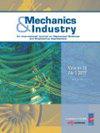Studying of parameters of two-phase displacement in porous media with MRI technique
IF 1.2
4区 工程技术
Q3 ENGINEERING, MECHANICAL
引用次数: 2
Abstract
This study describes experimental research on two-phase flow displacement using Magnetic Resonance Imaging (MRI) techniques. The overall purpose of this investigation is to determine kinetics process of phase trapping during (water-oil) two-phase flow, the front deformation and the phases saturation propagation along a vertical model. In these water flooding experiments, the porous medium model consists of packed beads of polystyrene (0.4 mm < dp < 0.6 mm) or sand grains (0.02 mm < dp < 0.50 mm). In order to conduct high accuracy experiments, a Nuclear Magnetic Resonance (NMR) spectrometer operating at 14 T (corresponding to a 600 MHz 1H resonance) equipped with an imaging device was used. With this equipment we can measure and visualize the two-phase flow in a vertical model of porous medium under ambient conditions. The obtained results have shown that the oil saturation profile is strongly influenced by the material properties such as the phase wetting, the sample porosity and permeability as well as the injection rate. The influence of flow velocity on the residual oil saturation was also studied. The experimental results allow an essential understanding of immiscible fluid displacement in two different types of porous medium that differ from each other mainly by the effects of wettability.用MRI技术研究多孔介质中两相驱替参数
本文介绍了利用磁共振成像技术对两相流驱替进行的实验研究。本研究的总体目的是确定(水-油)两相流动中相捕获的动力学过程、前缘变形和相饱和度沿垂直模型的扩展。在这些水驱实验中,多孔介质模型由聚苯乙烯填充珠(0.4 mm < dp < 0.6 mm)或砂粒(0.02 mm < dp < 0.50 mm)组成。为了进行高精度实验,使用了一台工作在14 T(对应600 MHz 1H共振)的核磁共振(NMR)光谱仪,并配备了成像装置。利用该装置,我们可以测量和可视化环境条件下多孔介质垂直模型中的两相流。结果表明,相润湿性、样品孔隙度和渗透率以及注入速率等材料性质对含油饱和度剖面有较大影响。研究了流速对剩余油饱和度的影响。实验结果使人们对两种不同类型的多孔介质中的非混相流体驱替有了基本的了解,这两种介质的主要区别在于润湿性的影响。
本文章由计算机程序翻译,如有差异,请以英文原文为准。
求助全文
约1分钟内获得全文
求助全文
来源期刊

Mechanics & Industry
ENGINEERING, MECHANICAL-MECHANICS
CiteScore
2.80
自引率
0.00%
发文量
25
审稿时长
>12 weeks
期刊介绍:
An International Journal on Mechanical Sciences and Engineering Applications
With papers from industry, Research and Development departments and academic institutions, this journal acts as an interface between research and industry, coordinating and disseminating scientific and technical mechanical research in relation to industrial activities.
Targeted readers are technicians, engineers, executives, researchers, and teachers who are working in industrial companies as managers or in Research and Development departments, technical centres, laboratories, universities, technical and engineering schools. The journal is an AFM (Association Française de Mécanique) publication.
 求助内容:
求助内容: 应助结果提醒方式:
应助结果提醒方式:


